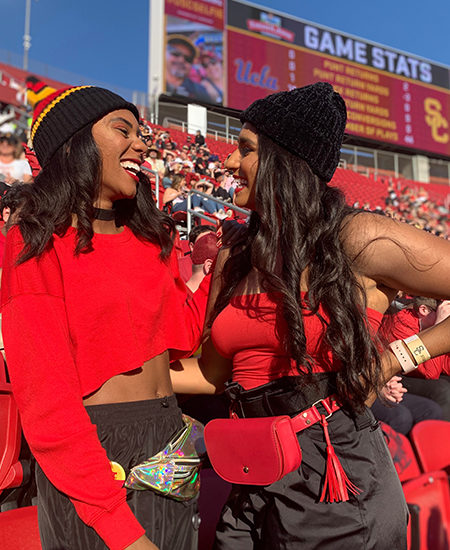Last updated 07/28/2021
By Helen Nguyen (USC Emeriti Center Student Worker)
George Floyd’s death was the tipping point for the Black community and the many activists involved in the Black Lives Matter movement. The horrid footage of former Minneapolis police officer Derek Chauvin suffocating George Floyd with his knee on Floyd’s neck for 8 minutes and 46 seconds enraged the entire country. Yet again, another Black man was taken due to police brutality, but with footage of this surfacing virtually everywhere, there would no longer be silence.

In wanting to help combat the racial injustice and systemic oppression evident in our country, Autumn Gupta, a USC Dornsife graduate, and Bryanna Wallace, a USC Marshall School graduate, decided to put their own knowledge and experiences into action, creating “Justice in June”, a comprehensive website with steps to become active allies to the Black community, links to multiple anti-racism resources, and even a schedule that accommodates each user on how much they want to learn in a day. As stated on their website, “This resource was compiled for the purpose of providing a starting place for individuals striving to become better and more active allies. The journey does not stop [after] just a month. We need everyone to do their part to amplify the conversation and help us take this moment to a movement.”

This website may sound very familiar to many of our readers in the retiree community as it was spotlighted in our Emeriti Center Intergenerational Zoom
Discussions: Black Lives Matter session. As it has been almost three months since that conversation, I want to continue to raise awareness about the situation and continue to spark conversations within the retiree community at USC Emeriti Center. I sat down (in a zoom call) with Autumn and Bryanna to ask them more about how to be an ally in the Black Lives Matter Movement and intergenerational activism.
In looking at activism and trying to take effective action against anti-racism, it is important that we each find our own lanes. Bryanna said, “Recognize that everyone’s social activism and how they’re contributing to the [movement] doesn’t and shouldn’t honestly look the same.”
While some can go out to the streets and protest, signing petitions, donating, or even just educating yourself and others, all create change that is larger than we perceive it to be. Both the younger and older generation must find their own area of service that provides personal rejuvenation while supporting justice and equality in our local communities. This can extend further than just the Black Lives Matter Movement. As Autumn put it, “allyship is advocating for others in any capacity and in any situation.” All of our actions have an effect, no matter how small we think it is, but at the end of the day, as long as we try to empathize with others and see humans as human beings, we can make a difference. Bryanna furthers the analogy by saying, “We’re all going towards the same destination and the same goal of achieving and conquering racial injustice and systemic oppression … Everyone’s lane is just as valid as the next person’s.” It can be as simple as having a conversation.
However, in almost every movement throughout history, there has and will always be someone or some institution who disagrees with your ideals and activism; people who refuse to hear what you say and leave you praying for the best. Personally, I have often hit this brick wall and exhausted nearly all of my energy trying to get through to them. In talking to Autumn and Bryanna, I realized that this by itself cannot be the goal. We have to admit to ourselves that we cannot win the hearts and minds of every single person with prejudiced beliefs and rather than trying to change their personal beliefs — some of which they have lived with all their lives. Autumn suggests we try to plant a seed in each of our conversations.
She said, “Some of those people are like they have the most fertile soil. It’s already raining, they’re ready to grow and the conversation becomes a flower, but other people might not be able to grow that flower.” Rather than trying to do the impossible in just a conversation, we should listen and be a resource for them to learn more when they get to that point in their lives. In light of that, all you can do is hope that the seed you planted grows.
While the movement currently seems to be spearheaded by the younger generation, Autumn, Bryanna, and I all agree that this movement is intergenerational. “If anything, we need their voices. Just like right now, the black community cannot do this by themselves. Everyone else has to take it on. At the same time, this generation cannot do it by ourselves.” The complexity of our society lies upon the beautiful concept of intersectionality, and at the end of the day, we are all bonded together by the fact that we are human and must be in this together. By sitting back and not doing anything, we contribute to the survival of the systemic racism and oppression the Black community faces daily. In final parting words of these two amazing women and fellow trojans, they ask the older generation and in sense the entire Trojan community to step outside of what is comfortable, learn about what is happening in our communities, and “be willing to be challenged and to be criticized, so that together collectively, we can all move forward.”To read more about these two inspirational women, the creation of their website, and their journey, please visit this article on USC Dornsife News or this article on the Washington Post.
